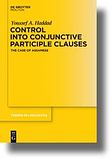Control into Conjunctive Participle Clauses
Haddad, Youssef A.:
Control into conjunctive participle clauses : the case of Assamese / by Youssef A. Haddad. - Berlin [u.a.] : De Gruyter Mouton, 2011. - XII, 226 S. : graph. Darst. - (Trends in linguistics : Studies and monographs ; 233)
Hochschulschrift. Teilw. zugl.: Gainesville, Univ., Diss., 2007
ISBN 978-3-11-023824-2
EUR 99,95
DDC: 491.4515
Beschreibung
The book explores Adjunct Control in Assamese, an Indo-Aryan language spoken in North India by about 15 million people. The author works within the Minimalist Program of syntactic theory. Adjunct Control is a relation of co-referentiality between two subjects, one in the matrix clause and one in the adjunct clause of the same structure. The relevant adjuncts in Assamese are non-finite clauses commonly known as Conjunctive Participle (CNP) clauses.
Four types of Adjunct Control are examined: (i) Forward Control, in which only the matrix subject is pronounced; (ii) Backward Control, in which only the subordinate subject is pronounced; (iii) Copy Control, in which both subjects are pronounced; and (iv) Expletive Control, in which case the two control elements are expletives. While Forward Control is a cross-linguistically common control pattern, Assamese also allows the other three less common structures.
The author analyzes Adjunct Control as movement and provides a detailed account of the conditions that drive and constrain each of the four types of control. The theoretical implications are highlighted.
The book is unique both empirically and theoretically. It is the first monograph which deals with Assamese generative syntax. It is also the first book to explore control structures in a single understudied language in such detail. In addition to Assamese, the book provides data from Telugu, Bengali, Konkani, Marathi, Tamil, and Hindi. [Verlagsinformation]
Inhalt
Acknowledgments. vii
List of Abbreviations. xiii
1. INTRODUCTION. 1
1. Research questions. 1
2. Domain of investigation. 2
3. Analytic approach. 4
4. Structure of the study. 28
2. ASSAMESE ADJUNCT CONTROL: A DESCRIPTIVE OVERVIEW. 30
1. Introduction. 30
2. Linguistic overview. 30
3. Case in Assamese: A descriptive overview. 32
4. Finite clauses in Assamese. 38
5. Nonfinite clauses in Assamese. 39
6. CNP clauses and Adjunct Control. 45
7. Conclusion. 67
3. FORWARD/BACKWARD ADJUNCT CONTROL: THE ANALYSIS. 69
1. Introduction. 69
2. Forward/Backward Control: The facts. 70
3. Assamese Adjunct Control as Obligatory Control. 83
4. Assamese Adjunct Control as sideward movement. 85
5. Multiple Case checking and Copy Control. 99
6. Case in raising vs. control. 101
7. Conclusion. 109
4. COPY ADJUNCT CONTROL: THE ANALYSIS. 111
1. Introduction. 111
2. Copy Control as movement. 115
3. Copy Control: The derivational history. 117
4. Copy Control and linearization. 120
5. Adjunction to CP and unwanted sideward movement. 136
6. Phonological realization of copies. 141
7. Conclusion. 150
5. ADJUNCT CONTROL VIOLATIONS AS EXPLETIVE CONTROL. 151
1. Introduction. 151
2. Nonvolitional as unaccusative. 156
3. Unaccusative predicates and Expletive Control. 157
4. English Expletive Control. 169
5. Conclusion. 175
6. TRIGGER: WHY MOVEMENT IN CONTROL? 176
1. Introduction. 176
2. Enlightened Self-Interest and control. 177
3. Event and control. 179
4. CP vs. IP and control. 182
5. Movement and predication. 188
6. Conclusion. 197
7. SUMMARY AND CONCLUSION. 198
1. Summary. 198
2. Theoretical implications. 200
3. Concluding remarks. 202
Notes. 204
References. 212
Index. 225
Autor
YOUSSEF. A. HADDAD, Assistant, Department of Modern Languages and Linguistics, Florida State University. Profile page.
Quellen: De Gruyter; Deutsche Nationalbibliothek; WorldCat; Amazon
Ähnlich
- Mylius: Lehrbuch der Ardhamāgadhī
- Vedic and Sanskrit Historical Linguistics
- Mylius: Zur Didaktik mittelindischer Sprachen
- Modi: Some Issues in Gujarati Phonology
- Indic across the Millennia
- Poudel: Eastern Nepali Grammar
- Verbeke: Alignment and Ergativity
- Linguistic Developments along the Silkroad
- A Grammar of Domari
- Grammar of Hadoti

